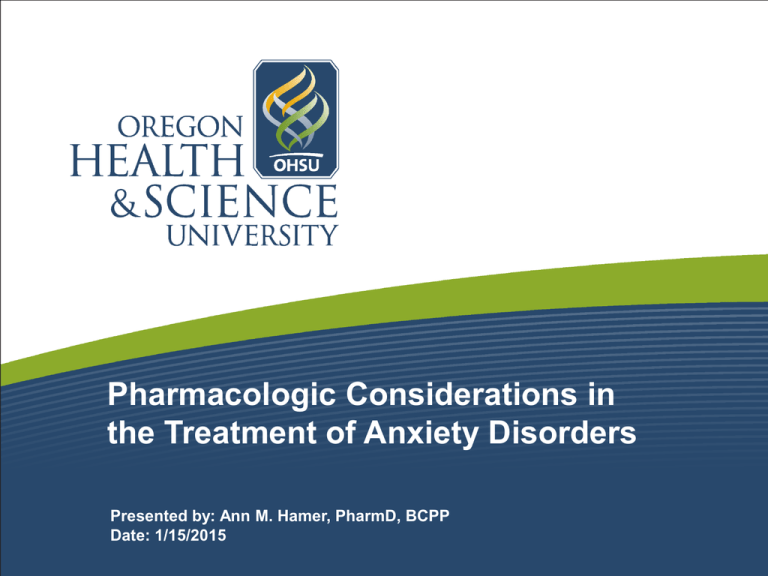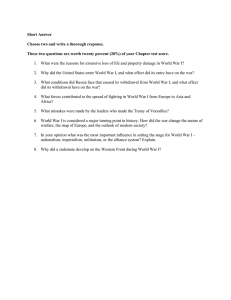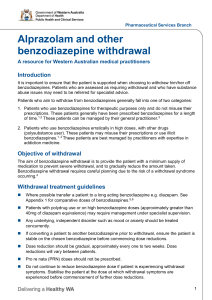Pharmacologic Considerations in the Treatment of Anxiety Disorders Date: 1/15/2015
advertisement

Pharmacologic Considerations in the Treatment of Anxiety Disorders Presented by: Ann M. Hamer, PharmD, BCPP Date: 1/15/2015 Disclosures and Learning Objectives • Learning Objectives – – – Be able to discuss first-line treatment recommendations for common anxiety disorders Be able to discuss benefits and risks of benzodiazepines Be able to identify differences between benzodiazepines Disclosures: Dr. Ann Hamer has nothing to disclose. Guideline Recommendation Grade Drug Class SSRIs Paroxetine Sertraline SNRIs Venlafaxine TCAs Amitriptyline Clomipramine MAOIs Phenelzine Ca Channel Modulators Pregabalin Gabapentin Panic GAD SAD OCD PTSD 1 1 1 1 1 1 1 1 1 1 1 1 1 1 3 2 1 3 2 2 5 1 Grade Key: 1=Category A evidence and good risk-benefit ratio 2=Category A evidence and moderate risk-benefit ratio 3=Category B evidence (limited positive evidence) 4=Category C evidence (evidence from uncontrolled studies or case reports 5=Category D evidence (inconsistent results) 3 5 Guideline Recommendation Grade Drug Class Benzodiazepines Alprazolam Clonazepam Tricyclic Anxiolytic Buspirone Atypical Antipsychotic Quetiapine Risperidone Other Mirtazapine Hydroxyzine Panic GAD SAD 2 2 OCD PTSD 3 5 1 3 3 2 Grade Key: 1=Category A evidence and good risk-benefit ratio 2=Category A evidence and moderate risk-benefit ratio 3=Category B evidence (limited positive evidence) 4=Category C evidence (evidence from uncontrolled studies or case reports 5=Category D evidence (inconsistent results) 3 Dosing Ranges of Grade 1 Agents Drug Class Panic SSRIs Citalopram Escitalopram Fluoxetine Fluvoxamine Paroxetine Sertraline 20-60 10-20 20-40 100-300 20-60 50-150 SNRIs Venlafaxine Duloxetine 75-225 GAD SAD OCD 10-20 10-20 10-20 20-60 100-300 20-60 50-200 20-50 50-150 75-225 60-120 Ca Channel Modulators Pregabalin 150-600 Atypical Antipsychotics Quetiapine 50-300 100-300 20-50 50-150 75-225 PTSD 20-40 20-40 50-100 75-225 Buspirone How does it work? • Selective 5HT1A partial agonist, with activity at both presynaptic and postsynaptic 5-HT1A receptors • Interacts with dopamine receptors as an agonist and/or an antagonist. • Appears to block presynaptic dopamine receptors selectively and produces an increased firing of midbrain dopamine neurons. • Thus, buspirone produces anxiolytic effects via postsynaptic receptor activity, while its activity at autoreceptors initially suppresses neuronal firing but gradually restores serotonergic neurotransmission. Buspirone Use in GAD: • Initial dose is 7.5mg BID. • • • May be increased every 2-3 days in increments of 2.5 mg twice daily to a maximum of 30 mg twice daily. There is a significant delay in the onset of clinical activity, which can vary from 2 weeks to much longer. Role: treating GAD in patients who cannot tolerate, or fail to respond to, an SSRI or SNRI Benzodiazepines • Since their introduction into medical practice in the 1960s, benzodiazepines have become one of the most widely used groups of medications • A WHO Task Force from the mid 1990s found that: • • 80% are prescribed by general practitioners Majority of users are chronic users https://www.erowid.org/pharms/benzodiazepine/benzodiazepine_info1.pdf Benzodiazepines National Ambulatory Medical Center Survey (NAMCS) found: • 12.6% of the primary care visits involved benzodiazepine or opioid prescriptions • 32.4% of ED visits • Prescription of benzodiazepines was found to increase by a rate of 12.5% per year (95% confidence interval [CI], 9.4% - 15.7%) http://www.cdc.gov/nchs/ahcd.htm Benefits of Use • Reduction of anxiety, induction and maintenance of sleep, muscle relaxation, and treatment and prevention of epileptic seizures. • These properties are shared by most currently approved benzodiazepines but to varying degrees, depending on their potency and pharmacokinetic properties. Baldwin DS, et al. Benzodiazepines: Risks and Benefits. A Reconsideration. J of Psychpharm. 2013; 27(11) 967–971. Agent Comparison Drug Onset of Action Peak Onset (hrs) Half-life (hrs) Elimination Dose Equivalent Chlordiazepoxide (Librium) Int 2-4 5-30 (parent) 3-100 (metab) Oxidation 10mg Diazepam (Valium) Rapid 1 20-50 (parent) 3-100 (metab) Oxidation 5mg Flurazepam (Dalmane) Rapid 0.5-2 47-100 (metab) Oxidation 30mg Alprazolam (Xanax) Int 0.7-1.6 6-20 (parent) Oxidation 0.5mg Clonazepam (Klonopin) Int 1-4 18-39 (parent) Oxidation 0.25mg Lorazepam (Ativan) Int 1-1.5 10-20 (parent) Conjugation 1mg Oxazepam (Serax) Slow 2-3 3-21 (parent) Conjugation 15mg Temazepam (Restoril) Slow 0.75-1.5 10-20 (parent) Conjugation 30mg Int 0.75-2 1.6-5.5 (parent) Oxidation 0.5mg Long-Acting Intermediate Acting Short Acting Triazolam (Halcion) Onset of Action: Rapid=within 15 min; Intermediate=15-30min; Slow=30-60min Risks of use • Cognitive effects • Sedation and drowsiness, mental slowing and anterograde amnesia • Dose dependent; +/- diminish with continued use • Psychomotor effects • • Impaired driving (potentiated by alcohol) Risk of falls • Psychomotor effects greater in elderly and with longeracting agents Baldwin DS, et al. Benzodiazepines: Risks and Benefits. A Reconsideration. J of Psychpharm. 2013; 27(11) 967–971. Risks of use • Tolerance • • Greatest with anticonvulsant and sedative effects Less with anxiolytic and hypnotic effects • Dependence • Physical and psychological withdrawal • Abuse • Greater attention to prescribing practices, particularly in combination with narcotics Baldwin DS, et al. Benzodiazepines: Risks and Benefits. A Reconsideration. J of Psychpharm. 2013; 27(11) 967–971. Reasons for discontinuation of BZs • Tolerance develops so they are no longer effective for the condition for which they were prescribed. • Dependence may develop, so that stopping will result in withdrawal symptoms, and the end result is long-term continuation in order to avoid withdrawal syndromes. • Prevention of adverse effects such as cognitive and psychomotor impairment, depression, irritability, loss of concentration and emotional blunting. • Reduce risk of falls in the elderly. • Reduce risk of accidents while driving. • Avoid potential interaction with other medication and with alcohol. http://www.patient.co.uk/doctor/benzodiazepine-dependence Clinical Considerations • Use lowest dose for shortest period of time • Benefit has been seen with short-term use (2-4 weeks) • Consider alternative agents for long-term needs • • Consider both nonpharmacologic and pharmacologic alternatives Dependence can be a significant issue for patients taking BZs for >1 month • All patients should be made aware of the risks of dependence with ongoing use • Periodic trials of dose reduction and cessation are recommended • High potency, short half-life agents more likely to cause dependence Benzodiazepine Withdrawal Dependence • • Associated with use >4 weeks Prevalence estimate: • 40% general practice pts; 63% psychiatric pts Factors associated with long-term use: • Psychiatric comorbidity, older age, less educated, living alone and using more avoidance coping behavior Kan CC, et al. Acta Psychiatr Scan 1997;96:85-93 Zandstra et al. Fam Pract 2004;21:266-9 Kan CC, et al. Acta Psychiatr Scan 1997;96:85-93, Zandstra SM, SM, et al. Fam Pract 2004;21:266-9 Benzodiazepine Withdrawal Advantages of withdrawal in long-time users Study reviewed changes in elderly patients’ cognitive function, quality of life, mood and sleep Findings: • 60% of pts had been taking the bz for >10yrs • 27% of pts had been taking the bz for >20yrs • Those that tapered off of the bz showed improvement on several cognitive and psychomotor tasks • Withdrawers vs. control did not differ in sleep or benzodiazepine withdrawal symptoms Curran HV, et al. Psychol Med 2003;33:1223-37 Curran et al. Psychological Medicine, 2003, 33, 1223–1237. Benzodiazepine Withdrawal Signs and Symptoms Tremors Anxiety Perceptual disturbances Dysphoria Psychosis Seizures Abrupt withdrawal can be dangerous Withdrawal Strategies Taper schedules Early stages of withdrawal are easier to tolerate than the later and last stages. Even short-term use may require a tapering off regimen (e.g. 2 weeks at lower doses) Optimal duration is not clear and may vary from patient to patient. In most patients, a brisk schedule (8-12 weeks) is possible. Longer-term users may require longer tapers (up to several months). 4 week taper at 25% per week—51% require slower d/c Withdrawal Strategies Taper schedules In patients who have tried and failed to withdraw previously, a 6-month schedule may be necessary. % of baseline dose Dosage (diazepam equivalents) 1 100.0% 15 2 73.3% 11 4 56.7% 8.5 6 40.0% 6 8 31.7% 4.75 10 23.3% 3.5 12 16.7% 2.5 100.0% 100.0% % of original dose Week 73.3% 75.0% 50.0% 40.0% 56.7% 23.3% 25.0% 14 13.3% 2 16 10.0% 1.5 13.3% 31.7% 6.7% 1 20 5.0% 0.75 22 3.3% 0.5 24 1.7% 0.25 26 0.0% 0 (STOP) 3.3% 0.0% 10.0% 0.0% 18 6.7% 16.7% 1.7% 5.0% 1 2 4 6 8 10 12 14 Week Number 16 18 20 22 24 26 Withdrawal Strategies Other considerations: Patients with underlying depressive illness should be treated with an antidepressant before withdrawal is started (consider an antidepressant with low withdrawal potential) Augmentation strategies have limited data Monitor for recurrence of original disorder The End! Next Week: Looking forward to a presentation by Dr. Betlinski

